Speech Towards a more Transparent Securitisation Market
Thank you for giving me the opportunity to speak here today.
When I addressed this forum two years ago, work was underway across industry to meet the RBA's new repo eligibility criteria for asset-backed securities. The criteria included providing the RBA with more information about the securities on issue from June 2015. We are now receiving that data and in my remarks today I would like to make a few observations on the data and outline where I think more work needs to be done in order to realise the goal of a more transparent market. But before doing this I'll summarise recent developments in the securitisation market.
Recent Developments
The Australian securitisation market experienced a gradual recovery following the global financial crisis, spurred initially by support from the Australian Office of Financial Management (AOFM) and demand from authorised deposit-taking institutions (ADIs, namely banks, building societies and credit unions) (Graph 1). However, issuance remains well below pre-crisis levels.

Residential mortgage-backed securities (RMBS) continue to form the largest part of the market, although there has been a notable reduction in issuance this year. Commercial mortgage-backed securities (CMBS) comprise only a tiny fraction of issuance, while other asset-backed securities (ABS) issuance is also quite small.
The stock of marketed securitisations outstanding is a little above $100 billion, compared with a peak of about $250 billion in 2007 (Graph 2).
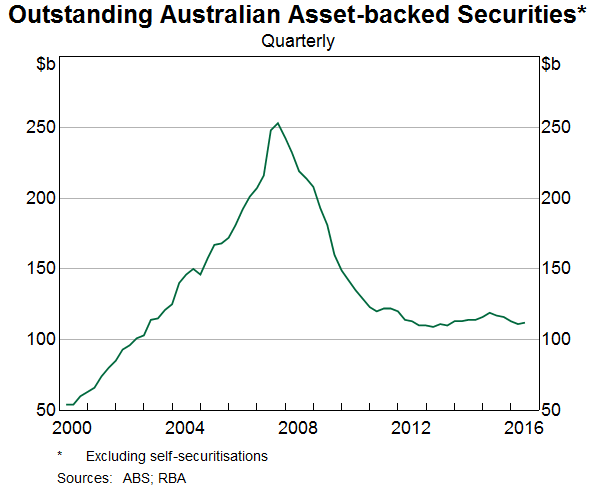
The decline in RMBS issuance this year has been driven by a significant reduction in issuance by banks (Graph 3). This reflects, among other things, less favourable conditions than in the senior unsecured wholesale debt market where banks have been able to issue in size and for longer maturities. The treatment of encumbered assets in the net-stable funding ratio also favours the issuance of senior unsecured debt over RMBS.
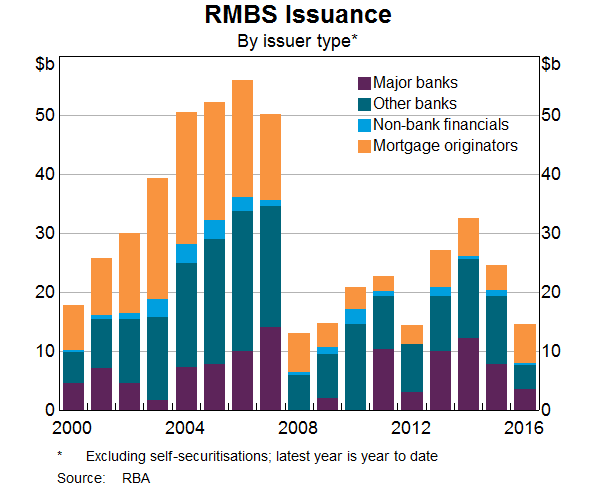
Consistent with the reduced presence of banks in the asset-backed market, the share of conforming RMBS issuance has declined.[1] In fact, over the past year non-conforming RMBS, which are mainly issued by non-bank mortgage originators, have accounted for about a quarter of total RMBS issuance, compared to a post-crisis average of around 5 per cent. Non-conforming RMBS have also become larger, with some recent issues being between $700 and $800 million – larger than any other non-conforming deal since 2007.
As noted previously, pricing on RMBS issuance has become somewhat less favourable relative to other sources of funding (Graph 4). Average primary market spreads on banks' conforming AAA rated RMBS rose markedly in early 2016, from around 100 basis points to around 150 basis points. While these spreads have recently come down a little, they remain higher than is usually the case relative to spreads on the major banks' unsecured Australian dollar-denominated bonds.
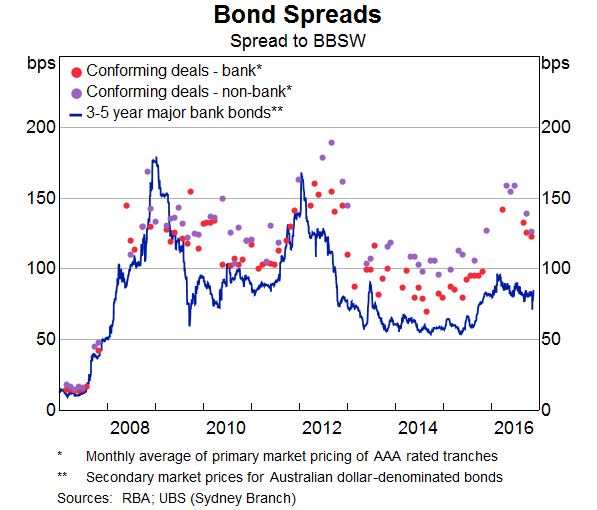
Before the crisis, typically around 40-60 per cent of ABS issuance was offshore. Since then, offshore issuance has been much smaller, and averaged around 4 per cent over the period 2012 to 2016. Some of this foreign demand may have been sated by covered bonds, the majority of which have been issued offshore. There is currently about $100 billion of covered bonds outstanding.
The investor base for Australian ABS has continued to evolve (Graph 5). Holdings of marketed ABS by ADIs have decreased a little over the past year or so, though they still remain high by historical standards, while there has been a pick-up in demand from real money investors.
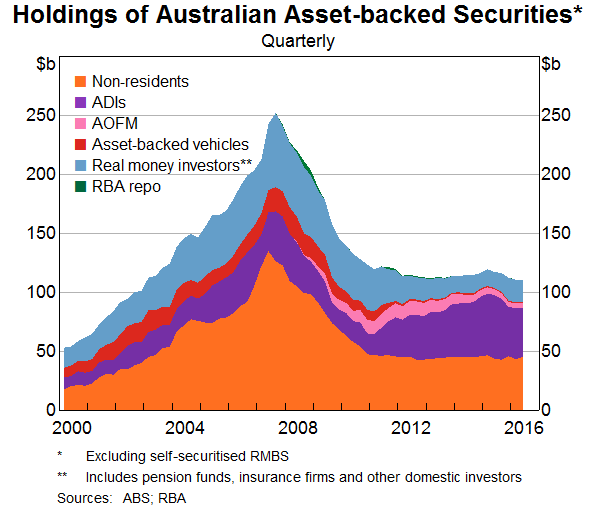
The Securitisation Dataset
Our understanding of developments in the securitisation market has been enhanced by the individual deal data that we are now receiving, and in particular the de-identified loan-level data. For RMBS, these data include: 62 fields related specifically to the loan, such as loan balances, interest rates and arrears measures; 18 fields related to the borrower, such as borrower income and employment type; and 13 fields that detail the collateral underpinning the mortgage, including the postcode and property valuation. Useful new information includes data on offset balances and borrower income at origination. In addition, issuers are required to provide a working cash-flow waterfall model of the security which provides useful information about structural aspects of ABS.
The dataset contains information from around 50 sponsors and 270 trusts on around 1,100 securities (Table 1). It covers around 2 million loans, the majority of which are residential mortgages, or around one-third of mortgages outstanding.[2]
| Sponsors(a) | Trusts | Securities | Loans | ||
|---|---|---|---|---|---|
| Total | RBA eligible | '000(b) | |||
| Marketed RMBS | 30 | 195 | 860 | 367 | 366 |
| Of which: | |||||
| - ADI | 21 | 145 | 514 | 256 | 311 |
| - Non-ADI | 9 | 50 | 346 | 111 | 55 |
| Non-marketed RMBS(c) | 40 | 49 | 107 | -- | 1,400 |
| CMBS | 2 | 3 | 23 | 5 | 1 |
| Other ABS | 7 | 26 | 127 | 24 | 407 |
| Total | 54 | 273 | 1,117 | -- | 2,174 |
|
(a) Sponsors organise a securitisation transaction to sell or transfer receivables (such as loans) that they
originated or acquired; the categories do not add to total because some sponsors are involved in multiple
categories Source: RBA |
|||||
As noted previously, the primary purpose for the RBA collecting these data is to allow it to manage its actual and contingent exposure to these securities. The RBA has accepted certain asset-backed securities as part of its regular market operations since 2007, and there are now nearly 400 eligible, marketed asset-backed securities that the RBA accepts under repurchase agreements (repo). While the RBA only accepts the AAA rated tranches in repo transactions and insists that these securities not have structural features or triggers that are particularly complex or unusual, they still have a wide range of features that make understanding the structure of the securities important. The assets underpinning them also range from household and commercial mortgages, through to auto loans and credit card receivables.
While we require these data to be collected for our own risk management purposes, the RBA also sees merit in the information on marketed securities being made available more broadly, in the interests of enhanced market transparency. Therefore, as part of our eligibility requirements for accepting certain marketed securitisations as collateral, we require issuers to make a significant share of the data they provide to us available more broadly to investors and other permitted data users.
The RBA also needs to understand non-marketed securitisations (known as self-securitisations) because these are potentially a significant share of the collateral used in our standing facilities. The Committed Liquidity Facility (CLF) is a large contingent liability for the RBA. It is used by ADIs to meet their liquidity requirements under the liquidity coverage ratio. The CLF enables participating ADIs to access a pre-specified amount of liquidity from the Reserve Bank by entering into repurchase agreements of eligible securities outside of our normal market operations. The current size of the CLF is $245 billion.
The self-securitisations are also used to cover payment settlements that occur outside business hours under the RBA's ‘open repo’ arrangements. These arrangements, which permit banks to convert these securities to exchange settlement balances at the RBA, will become increasingly important as we move to the new payments platform (NPP) in late 2017. From this time more payment settlements will be occurring outside business hours, including over the weekend.
So what can we see in the data?
Debt securities
On the liabilities side, we have a wealth of information about the structure of each ABS. The main liabilities of a securitisation are the issued notes, which may be structured quite differently across deals. For example, RMBS marketed by the ADIs tend to have very simple structures, commonly one large senior note with relatively little subordination (Graph 6).[3] In contrast, the RMBS structures issued by non-ADI mortgage lenders typically require a larger amount of subordination in order for the senior tranches to obtain a AAA rating, as the loan pools typically have a larger share of non-conforming loans. Another common feature of non-ADI deals is the large number of subordinated tranches.

The structure of different securitisations may change over time. This reflects the operation of each trust's cash-flow waterfalls, which determine the linkages between the assets, the trust support features and the liabilities. The waterfalls specify the precise rules for the ordering of cash allocations in each period of the trust's lifetime.[4] As noted previously, the ordering and linkages within the cash-flow waterfalls permit a better understanding of the risk characteristics of individual deals.
These models of the cash flows allow us to monitor the performance of a deal and observe how it performs under a range of scenarios, including stress scenarios. For example, one risk associated with RMBS is prepayment risk, as mortgagees have the option to pay back their loans ahead of schedule. We can now observe how note balances and credit support evolve under different prepayment rates (Graph 7).[5] In this case, a higher prepayment rate results in the principal outstanding on the senior notes being paid down faster; it also leads to higher credit enhancement sooner.

How each securitisation addresses mismatches between assets and liabilities and, in particular, the role of various support facilities such as those that provide the trust with liquidity, or mitigate its interest rate risk, is explicit in the data. Each deal will have several facilities, which may be provided by a number of different parties and potentially by a counterparty presenting the security as collateral to the RBA. This is particularly important for the RBA because of its relevance to how we mitigate ‘wrong way’ risk – that is, the risk that our exposure to a counterparty increases as the credit quality of that counterparty declines. To deal with this, additional repo haircuts are applied if the counterparty is ‘related’ to the asset-backed security presented to the RBA.
Loan-level information
The source of the cash flows needed to support the trust's liabilities is the underlying asset pool. The new securitisation dataset provides important information on the quality of the underlying assets, by providing a detailed description of the associated collateral, borrowers and loan contracts. The loan-level data contain static information determined at origination (such as the type of collateral and its geographical location) and data that changes over time (such as the loan balances, loan-to-valuation ratio and arrears rates).
Features of the underlying assets can vary considerably across securitisations (Graph 8). The loans underpinning both the major bank and non-ADI securitisations shown here are geographically diversified across states, with the non-ADI deal a little underweight in NSW and overweight in Victoria relative to those states' shares of the Australian population. At the same time, the non-ADI deal is more heavily concentrated in postcodes that are more distant from the centre of the capital cities than the major bank securitisation (Graph 9).
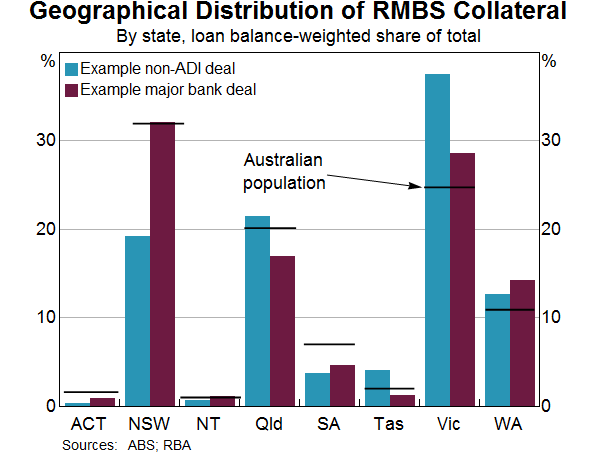
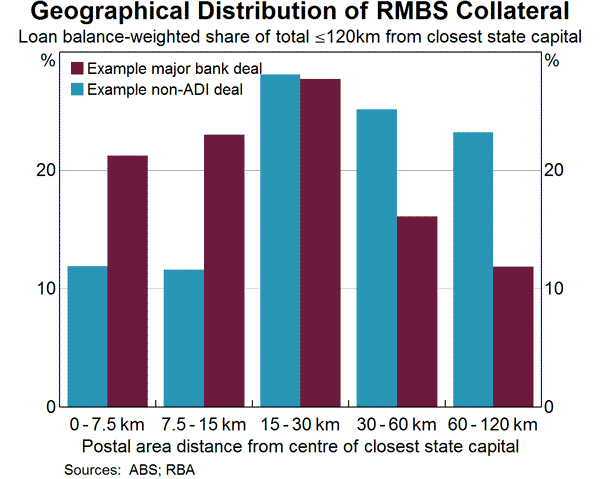
The interest rates paid by borrowers can also differ markedly across deals in the market, reflecting the considerable variation in characteristics of borrowers and lenders (Graph 10). Consistent with a loan pool comprising a higher share of non-conforming loans and self-employed borrowers, almost all loans backing the non-ADI deal shown here pay higher interest rates than those in the major bank deal (although again there is considerable variation across individual ADI and non-ADI deals).
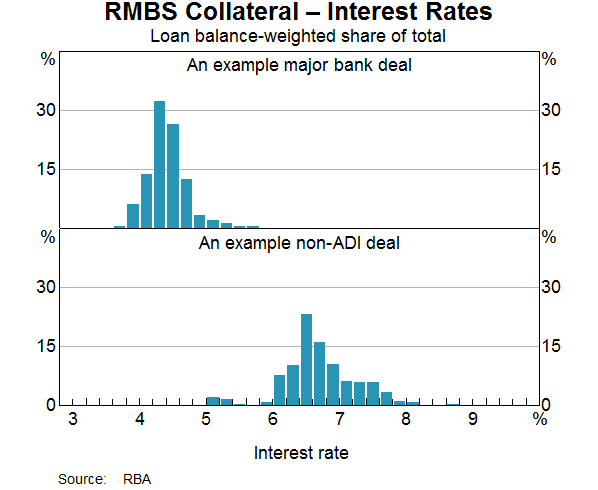
It is also possible to monitor the quality of a security's underlying assets over time (Graph 11). For example, at origination, a large share of the loans in these two deals had loan-to-valuation ratios (LVRs) close to 80 per cent, although the non-ADI deal had fewer loans with LVRs above this threshold. But now that the loans have aged, more recent data show that the LVRs are less concentrated as some of the loans have been paid down over time (although the data may not capture changes in valuations). The smaller shift in the distribution of the non-ADI deal could reflect a higher share of interest-only loans and/or a difference in the loan seasoning between the two portfolios, for example.
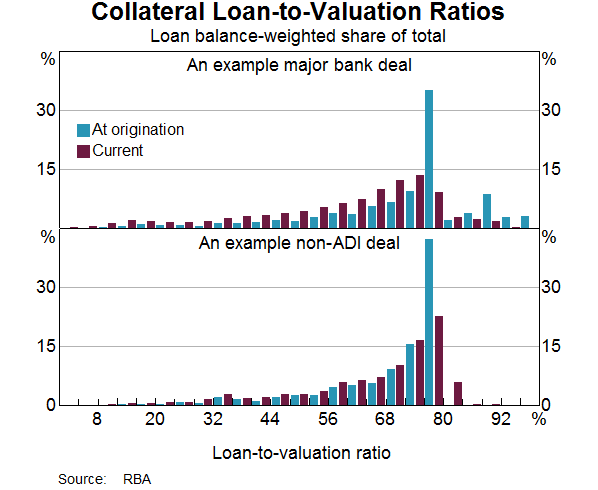
We are also able to analyse the distribution of arrears rates for securitised residential mortgages across Australia. Graph 12 shows that mortgage arrears are highest in Western Australia and Queensland, and in non-metropolitan regions, particularly those near mining operations.
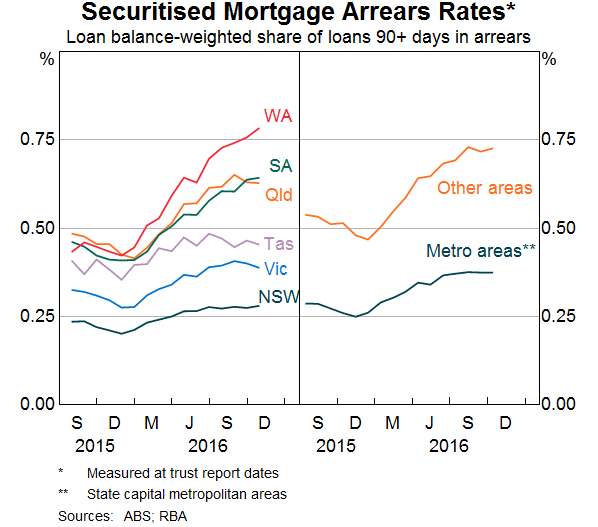
The next steps for the RBA will be to develop an internal collateral pool model using, for example, credit risk models that take into account characteristics such as geographic concentrations, delinquencies and loan-to-value ratios.
Areas for Further Development
So what have we observed about the quality of the data, and where to from here?
The first point that I would make is that the data quality is generally good, though there is still scope to improve the accuracy, consistency and completeness of the data.
There is little consistency in reporting around credit scores and debt serviceability metrics. The RBA does not currently require this information to be made available to users of the data, but did flag last year that it would review this requirement once the information was collected. The RBA's assessment is that because issuers are using very different measures and these metrics are currently being reported for only around half or three quarters of loans depending on the measure, publication would do little to enhance transparency at this stage. This will remain a ‘work-in-progress’ for the time being.
To improve data quality further, the RBA has continued to roll out more validation rules. To date, these rules have targeted the most critical fields for eligibility and the calculation of haircuts, ensuring that the information is complete and within plausible ranges. The rules also check for the completeness and internal consistency of the data. These checks will become increasingly sophisticated, focusing in particular on ensuring that the data evolve in a consistent manner over time.
The feedback that we have received from investors and other market participants is that, to date, the process for gaining access to the data is cumbersome, particularly the need to sign access deeds. With this in mind the ASF has recently released a new standard framework for loan-level data disclosure. The framework is a recommended minimum standard for industry participants when providing and receiving loan-level data for RMBS. The primary purpose of the framework is to mitigate certain risks, but particularly those relating to privacy where sponsors have to manage the risk around the possible re-identification of data.
There is more interest in the new data from buyers of lower-rated tranches, but this has not yet opened up a new investor base as investors have tended to rely on existing means of access to the relevant information. Better access arrangements would promote greater interest in the data from a wider investor base. It would also assist in the monitoring of deals so that investors can satisfy themselves that they are receiving the correct cash flows.
As I mentioned earlier, one of the RBA's requirements for ABS to be considered repo eligible is that a large proportion of the new dataset (including summary stratification tables) be made available to the public. We will shortly be surveying information providers to see how this requirement is being met. Of particular interest is how users are accessing the securitisation data, how many requests have been received, the type of data request and take-up by investors and other permitted users.
The RBA is also planning to align the deadline for reporting to the RBA with the date that investor reports are due. This would remove the current mismatch and allow the RBA and other permitted users to price and assess the credit risk of these securities more accurately, and in a more timely manner.
In the interest of transparency, the RBA is now publishing information on our website about the progress of applications for securities to be considered eligible for the RBA's market operations.[6] This information includes details of securities that have been made ineligible because the ongoing reporting requirements have not been met.
Conclusion
In conclusion, the securitisation market is changing, with less involvement of the major banks more recently and an increased share of non-conforming mortgages. It has also come a long way in terms of the provision of data. But it still has a way to go if it is to approach best-practice and attract new investors. The RBA looks forward to continuing to work alongside industry and the Australian Securitisation Forum over coming years.
Thank you for your time.
Endnotes
I would like to thank Kate Davis, Michael Tran, Michelle Bergmann and Alex Cooper for assistance in the preparation of these remarks. [*]
Conforming loans meet standard lending criteria, which are typically consistent with the requirements for lenders' mortgage insurance, whereas non-conforming loans do not. For example, non-conforming loans include those to borrowers with a poor credit history or who cannot provide the usual income verification documents (which is common among the self-employed). [1]
‘Loan’ is used to refer to all receivables including mortgage loans, other personal or corporate loans, leases and hire purchases. [2]
Tranches (labelled A1 to F, and equity, in Graph 6) refer to the order in which the RMBS notes receive principal payments and are allocated losses. For more detail see Arsov I, Kim I S and Stacey K (2015), ‘Structural Features of Australian Residential Mortgage-backed Securities’, RBA Bulletin, June, pp 43–58. [3]
The cash-flow waterfall is a set of rules that determine how the payments of interest and principal are made to the notes, and how losses are allocated. See Arsov et al (2015). [4]
The clean-up call option allows the sponsor to buy back all of the outstanding notes when certain conditions are met. Typically, clean-up calls can be exercised when the outstanding mortgage pool balance falls below a certain proportion (often 10 per cent) of its initial value and, in the case of non-ADI RMBS, a clean-up call can be exercised after a certain date. Again, see Arsov et al (2015) for details. [5]
See spreadsheet ‘Outstanding Repo Eligibility Applications and Ineligible Securities’ [6]
